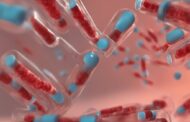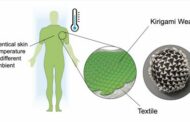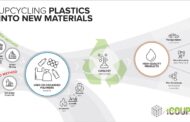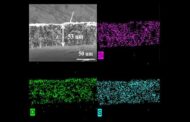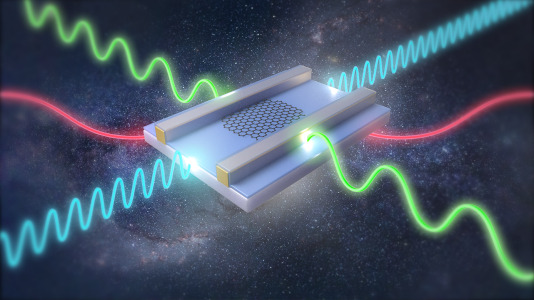
Artistic rendering of water sensor with graphene-based nanolayer and two electrodes attached at top. Alternating current voltages at varying frequencies (wavvy lines) are used to rapidly and non-destructively screen for high-quality sensor devices.
(Image by Argonne National Laboratory.)
New screening method eliminates faulty electronic sensors for measuring toxins and other elements in water
Major step toward large-scale manufacturing of uniform and reliable smart sensors for real-time monitoring of multiple constituents in water.
There is a global water crisis, and it is not only about the dwindling supply of clean water. Contaminated drinking water exposes hundreds of millions of people worldwide to toxins, such as bacteria, heavy metals, pesticides and coronaviruses. This contamination imperils public health and can cause serious illnesses.
A team of researchers from the U.S. Department of Energy’s Argonne National Laboratory, along with the Pritzker School of Molecular Engineering at the University of Chicago and the University of Wisconsin — Milwaukee, has devised a pathway for the mass manufacture of sensors able to simultaneously detect lead, mercury and E. coli. in flowing tap water. The team’s innovation promises to help safeguard public health by providing early warning for contamination.
“Traditionally, sensors designed to measure contaminants in water have suffered from reliability issues and the inability to detect faulty devices,” said Argonne scientist Haihui Pu, who holds a joint appointment with UChicago’s Pritzker Molecular Engineering. ?“Improved sensors could avert health crises.”
At the core of these sensors lies a one-nanometer-thick layer of carbon and oxygen atoms, a form of graphene, which is coated on a silicon substrate. This graphene material serves a similar purpose to the semiconductors found in computer chips. Gold electrodes are then imprinted onto the graphene surface, followed by a nanometer-thick insulating layer of aluminum oxide. Each sensor is tailored to detect one of the three toxins: lead, mercury or E. coli.
One of the major challenges in mass manufacturing these sensors has been assessing their quality. Tiny areas of undesired porosity can form in the ultra-thin insulating layer. This porosity allows electrons from the bottom graphene layer to escape into the top insulating layer. This leakage compromises its effectiveness as an insulator and results in unreliable sensor responses.
The team’s recent publication in Nature Communications describes a screening method to identify defective devices before mass production. The method involves measuring the electrical response of the insulating layer while the sensor is submerged in water. Key is that the screening does not damage the sensor. By employing this technique, the team identified structural defects in the insulating layers. They were then able to establish criteria to easily detect faulty devices.
To demonstrate the efficacy of their approach, the team evaluated a three-sensor array able to simultaneously detect lead, mercury and E. coli in flowing tap water. Using machine learning algorithms to analyze the results, they were able to quantify toxin levels down to the parts per billion, even in the presence of interfering elements.
“The beauty of the sensors is that you can apply them in any form of water, not just tap water,” said Junhong Chen, Argonne’s lead water strategist and Crown Family Professor at Pritzker Molecular Engineering. ?“What’s more, you can combine three, thirty or three hundred sensors, with each tailored to detect different constituents.” These include not only heavy metals and bacteria, but pharmaceuticals, pesticides, coronaviruses and a common contaminant in water, per- and polyfluoroalkyl substances. They might also include critical resources, such as cobalt for batteries and nitrogen and phosphorus as nutrients for plants and animals.
Once problematic or valuable elements are identified and removed, the sensors can be used to assess the cleanliness of treated water. The results can guide the safe reuse of the water, including potable use, agriculture and irrigation, groundwater replenishment and industrial processes.
Chen expressed hope for commercializing this technology through a startup company he founded. ?“But water contamination poses a global health problem demanding collective efforts,” he said.
The team’s screening method offers a versatile tool for monitoring water quality and optimizing its safe reuse. As scientists tackle this critical issue, their efforts serve as a beacon of hope for a healthier, more sustainable future.
Original Article: Pivotal discovery in sensor technology to combat water contamination and more
More from: Argonne National Laboratory | University of Chicago | University of Wisconsin–Milwaukee
The Latest Updates from Bing News
Go deeper with Bing News on:
Real-time water monitoring
- Trial to Begin for Military Families Suing over Hawaii Water Contamination
The trial, which will include 17 of the more than 7,500 plaintiffs across three lawsuits, will explore whether the U.S. government owes damages to military housing residents who consumed jet fuel.
- Veolia, Sewerage and Water Board of New Orleans partner on wastewater treatment
Veolia North America and the Sewerage and Water Board of New Orleans (SWBNO) have established a groundbreaking partnership to reimagine how the US city collects, treats and manages its wastewater.
- Meet the Environmental Monitoring Award finalists in the 2024 Australian IoT Awards
Including drones to measure and geolocate radiation sources and low cost air quality monitoring for NSW councils.
- Lake Erie buoys provide eclipse, water quality data
The series of connected buoys — called Smart Lake Erie Watershed (SLEW) — covers 6,500 square miles and is made up of hundreds of advanced sensors installed throughout the lake's watershed. These ...
- Cyclopure Water Test Kits Used in Colorado Pilot Program to Test for PFAS in Private Well Water
While the new rules include monitoring requirements for public water systems, testing individual wells for ... water through a DEXSORB-loaded extraction disc in a collection cup. Real-time PFAS ...
Go deeper with Bing News on:
Water monitoring
- ‘Waste of Water’ ordinance goes into effect May 1 in Golden
GOLDEN, Colo. (KDVR) — A new ordinance to crack down on water usage in the city of Golden is set to take effect on May 1. While there are potential penalties for wasting water, the goal of the city’s ...
- Looking back and looking forward on our beach monitoring season
Every summer we monitor beaches for fecal bacteria to protect beachgoers. Read our 2023 BEACH Program report and send us feedback on the proposed list of beaches that will be monitored in 2024.
- DHEC’s seasonal water quality monitoring at S.C. beaches begins May 1
To help keep South Carolina beaches a favorite destination during the summer months, the South Carolina Department of Health and Environmental Control (DHEC) is set to resume its ...
- Israel’s Military Campaign Has Left Gaza’s Medical System Near Collapse
The Israeli military’s bombardment and invasion of Gaza have decimated its health care system in a way that aid groups and international bodies are increasingly calling “systematic.” ...
- Volunteer Water Monitoring program
As spring arrives in Minnesota, it’s time for the Minnesota Pollution Control Agency (MPCA) to kick off its popular program that relies on Minnesotans to monitor our 12,000+ lakes and ...




